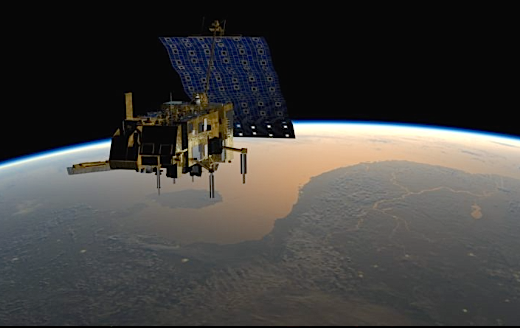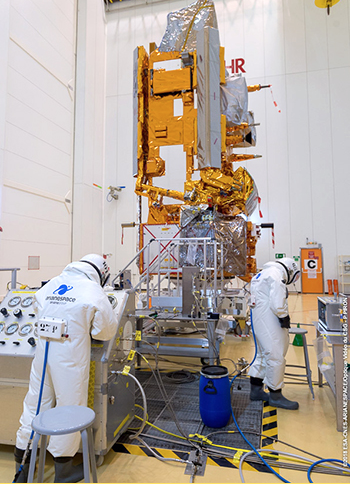

The Metop-C Satellite
This will be the last of the trio to be launched, and now it seems that the weather is taking a turn for the better at Arianespace's Spaceport for the upcoming Metop-C satellite.
The Soyuz vehicle for Arianespace’s next medium-lift mission has moved to the launch zone in French Guiana, where it stands ready to receive the Metop-C satellite passenger that will be lofted on this November 6 flight.
In procedures that have become familiar at the Spaceport, Soyuz was moved via a transport/erector rail car in a horizontal-transfer process from the MIK launcher assembly facility to the ELS launch complex. Once over the launch pad, the vehicle was erected into a vertical orientation, where it is suspended in place by four large support arms.

The Metop-C satellite for Arianespace’s upcoming Soyuz launch is fueled in the Spaceport’s S3B clean room facility.
Following this step’s completion, the mobile gantry was moved into position over the launcher – providing protection for the upcoming installation of Soyuz’ “upper composite,” which consists of Metop-C, the Fregat upper stage and payload fairing.
Next week’s launch – designated VS19 in Arianespace’s numbering system – is scheduled to lift off at precisely 9:47:27 p.m. local time in French Guiana, with Metop-C to be deployed into a polar sun-synchronous orbit during a flight lasting approximately one hour. Total payload lift performance is estimated at 4,212 kg.
Built by Airbus Defence and Space, Metop-C continues the European Meteorological Operational program of polar-orbiting spacecraft operated by the European Organisation for the Exploitation of Meteorological Satellites (EUMETSAT). The first two satellites – Metop-A and Metop-B – were launched on Soyuz vehicles from Baikonour in 2006 and 2012, respectively, by Arianespace’s European-Russian joint venture, Starsem.
Metop spacecraft carry a payload of instruments to measure a wide range of variables – such as temperature and humidity, wind speed and direction over oceans, ozone and other atmospheric gases – marking major advances in global weather forecasting and climate monitoring capabilities.
Flight VS19 will be Arianespace’s eighth flight of the year across its full launch vehicle family (which also includes Ariane 5 and Vega), and the second in 2018 with Soyuz – following the March 9 mission that lofted four additional spacecraft for SES’ O3b Medium Earth Orbit (MEO) satellite constellation.
The program also represents the European contribution to a cooperative venture with the United States’ National Oceanic and Atmospheric Administration (NOAA), which has been delivering meteorological data from polar orbit, free of charge, to users worldwide during the past 40 years.

